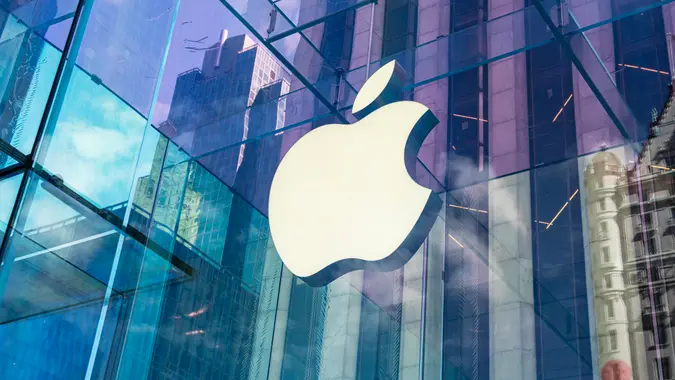Tesla Stock: 6 Warning Signs Every Investor Should Know

Commitment to Our Readers
GOBankingRates' editorial team is committed to bringing you unbiased reviews and information. We use data-driven methodologies to evaluate financial products and services - our reviews and ratings are not influenced by advertisers. You can read more about our editorial guidelines and our products and services review methodology.

20 Years
Helping You Live Richer

Reviewed
by Experts

Trusted by
Millions of Readers
Tesla is one of those stocks people will always brag about getting in on the ground floor of, like Microsoft or Apple. If you missed the opportunity to buy 10 years ago, you may be considering a purchase today. Is Tesla a tech stock for the future, or is it too risky?
Here are six warning signs every investor should know about Tesla stock.
1. Sky-High Valuation
This may be the biggest red flag of all when it comes to Tesla stock. The company presently has a market capitalization of $1.434 trillion. Yet, according to NPR, profits declined 13.5% in Q2. Q3 may see a surge in revenue as consumers purchased cars ahead of the expiration of electrical vehicle (EV) tax cuts, but that’s a temporary gain.
As of Oct. 10, 2025, Tesla’s profit-to-earnings (P/E) ratio was $258.73. Keep in mind that the P/E ratio is the amount investors are willing to spend for a dollar of a company’s earnings. So, Tesla investors are paying over $250 for every one dollar of earnings. By contrast, Ford Motor Company’s P/E ratio is $14.80. Even tech darling Nvidia has a P/E ratio of $55.08.
2. New Ventures
It can be challenging to compare Tesla to other companies because, while it is an auto company, it also has many new tech-adjacent businesses in the pipeline. If all of these ventures, like self-driving cars and robotics, pan out as expected, the company’s performance will likely align with expectations. But that is far from certain. The market’s willingness to price in projects that are still in development is concerning.
3. Concentrated Leadership
As Tesla’s CEO, Elon Musk can be an asset and a liability. His energy and creativity have certainly brought the company to where it is today, and his words and actions can affect the movement of the stock. But there is a risk that he could lose focus by exploring too many new ventures at once, and his political stances are bound up with regulatory decisions that would affect the business.
This year also saw the Tesla Takedown boycott in response to Musk’s public persona, and a National Bureau of Economic Research study claims his public behavior has cost the company the sale of 1.25 million vehicles over the past three years. At about $40,000 per vehicle, that’s a colossal opportunity cost in the realm of a $50 billion blunder, if accurate.
4. Subsidies and Incentives
Manufacturing subsidies and incentives for consumers to purchase have greatly aided the adoption of electric vehicles. While these programs have been effective in advancing EVs’ popularity, the industry’s dependence on them in general, and Tesla in particular, is a red flag.
Programs that make it less expensive to manufacture electric vehicles include the Qualifying Advanced Energy Project Credit, which provides a tax credit for companies that expand clean energy manufacturing and recycling capacity and reduce greenhouse gas emissions at industrial facilities.
Consumer incentives, including federal, state, and local tax credits, were implemented to increase consumer adoption of electric vehicles. Some state and local incentives remain, but the federal Clean New Vehicle Credit expired on Sept. 30, 2025. If more programs like these are scaled back or eliminated, the cost of EVs will rise, which could impact Tesla’s earnings.
5. Competitive Pressures
Tesla didn’t invent the electric car — that happened in the 1800s, according to the U.S Department of Energy. But electric vehicles became mainstream around the turn of the millennium, when Toyota’s Prius and Honda’s Insight hybrids began to be sold in the U.S. When Tesla introduced the Model S, it brought luxury to the EV market, and the company quickly became the leader in the industry.
With 30 different companies now selling electric vehicles in the U.S., according to Car and Driver, competition is heating up. Automakers from Fiat to Rolls Royce have electric options, and the variety of available vehicles will ultimately lead to cost and price pressure.
6. Price Volatility
Any investor who has held on to Tesla stock for a while can vouch for how volatile it is. From the start of the year to Oct. 10, 2025, the stock is up 8.86%. Over the past 12 months, however, it’s up 84.12%. Clearly, the price spike at the end of 2024 is responsible for this discrepancy, but that’s a glaring comparison.
Another notable metric is the stock’s 52-week range of $212.11-$488.54. Analysts’ price targets are also all over the map, ranging from $120-$600 per share. The average 12-month target is $360.63, compared with the stock’s current price of $439.51.
It’s hard to say if Tesla stock is a good buy at this point — even the analysts are split pretty much down the middle. Keeping these warning signs in mind can help you make an informed choice about this stock.
More From GOBankingRates
- Nearly 1 in 3 Americans Hit by a Costly Holiday Scam, Norton Survey Shows -- How To Avoid This
- Here's What Retirees Wasted the Most Money On in 2025 -- and How To Avoid It in 2026
- How Middle-Class Earners Are Quietly Becoming Millionaires -- and How You Can, Too
- 6 Safe Accounts Proven to Grow Your Money Up to 13x Faster
 Written by
Written by  Edited by
Edited by 

























